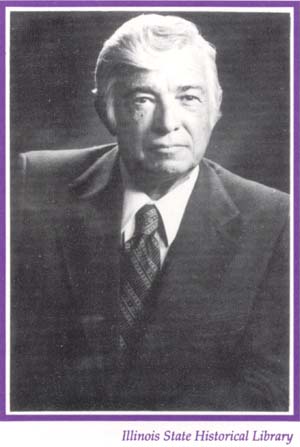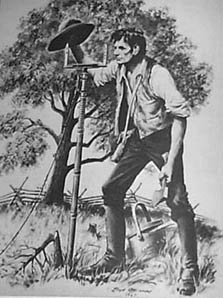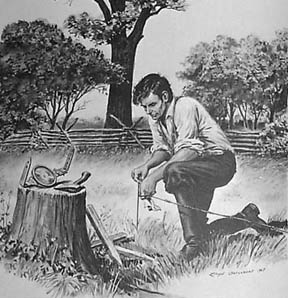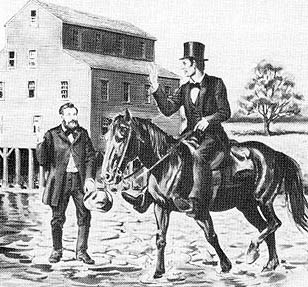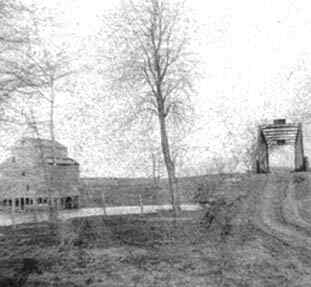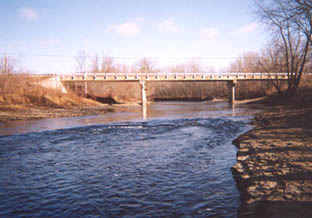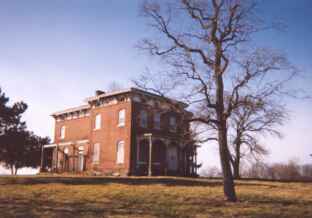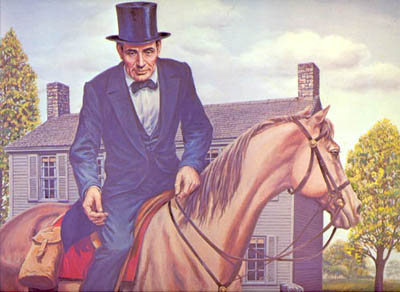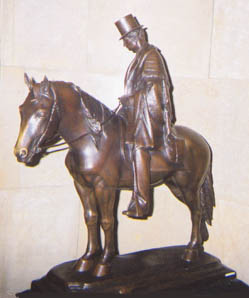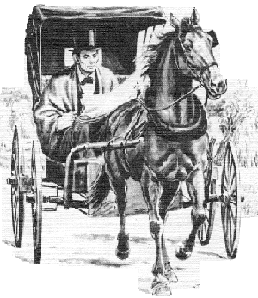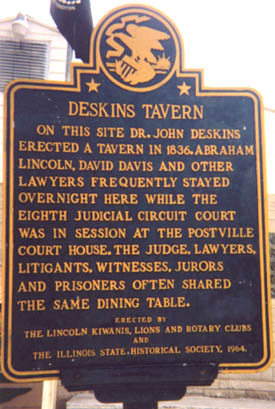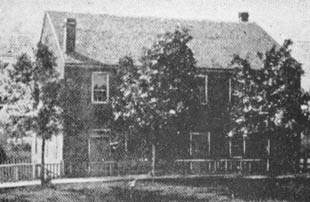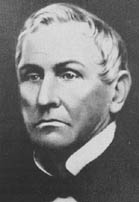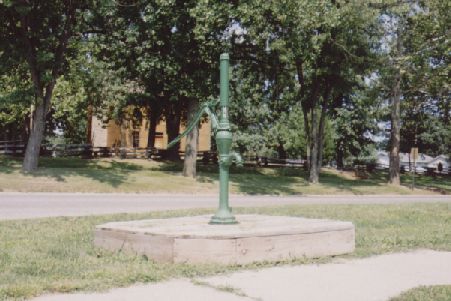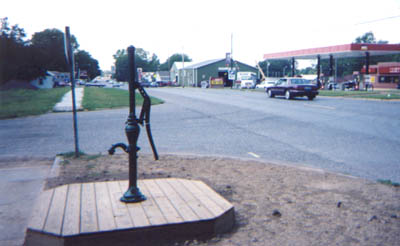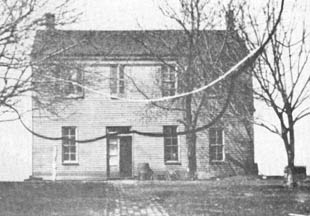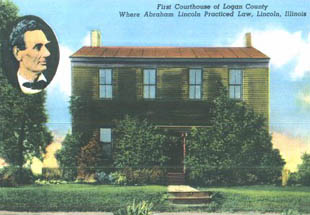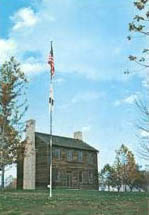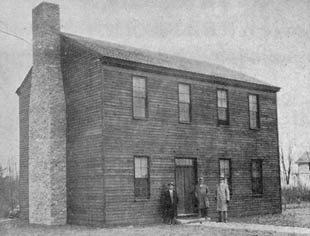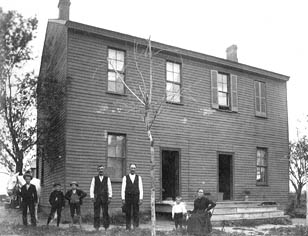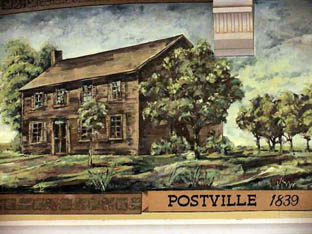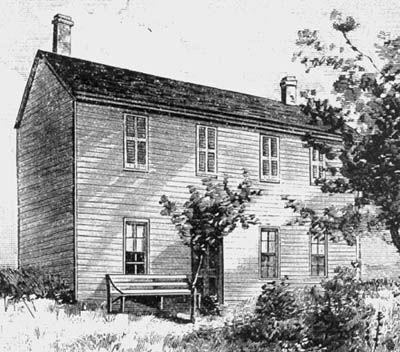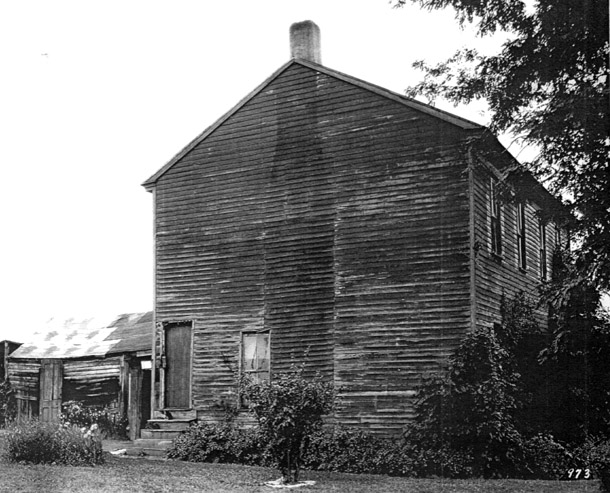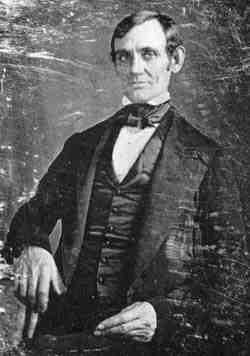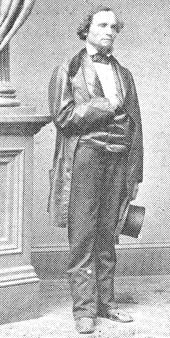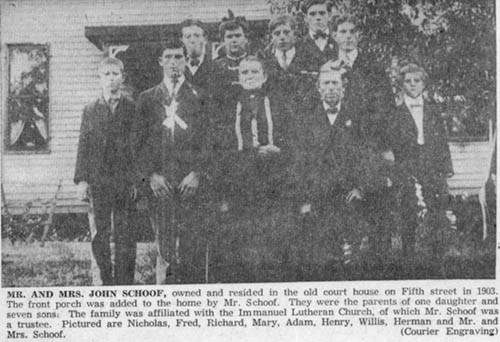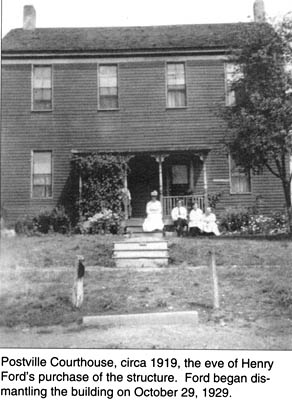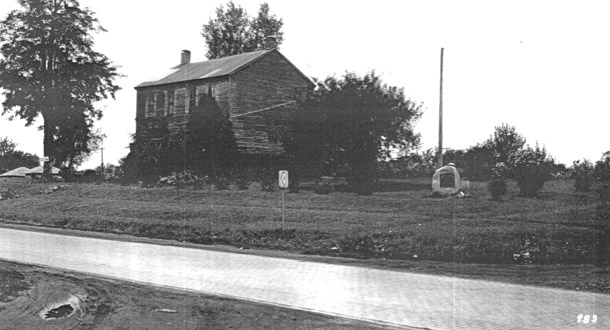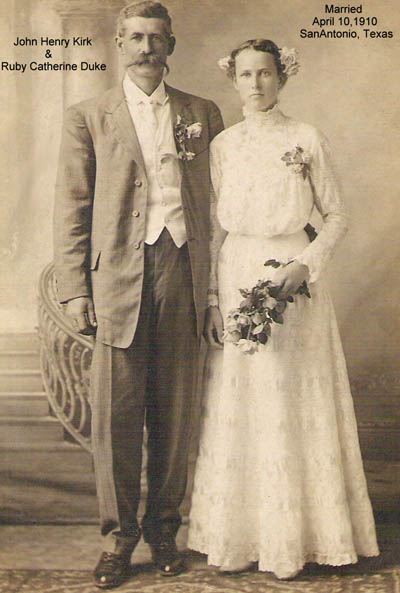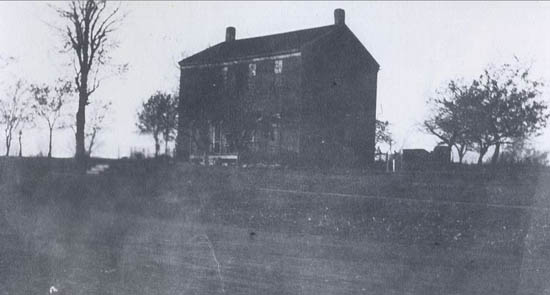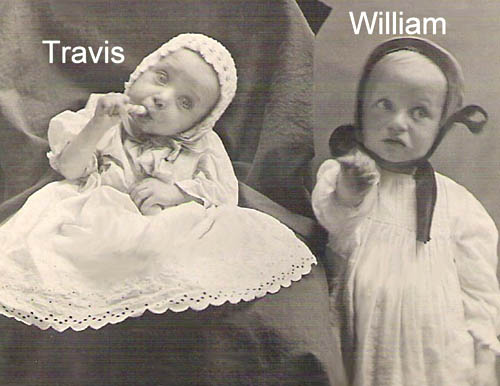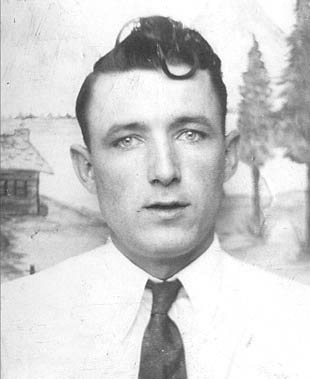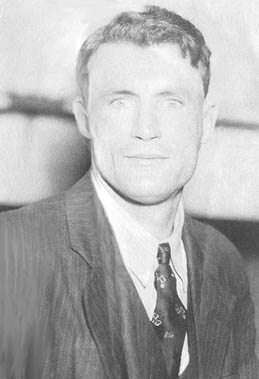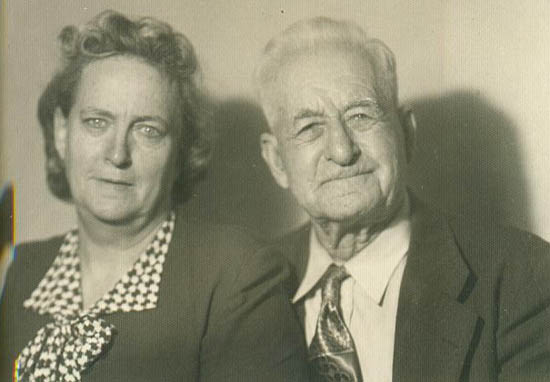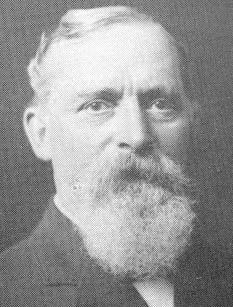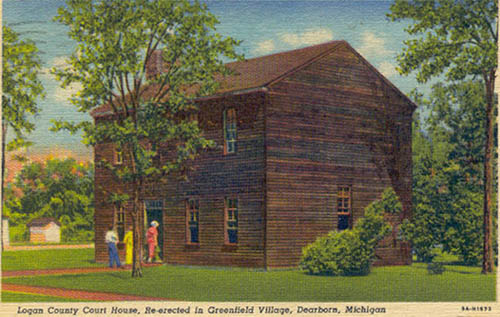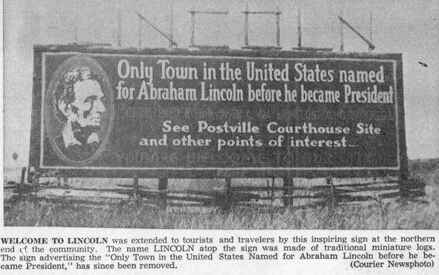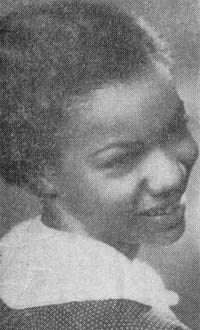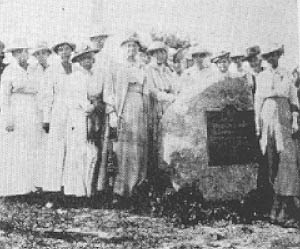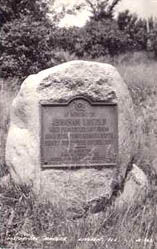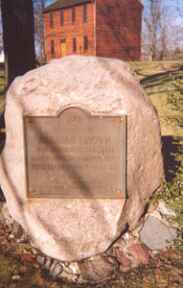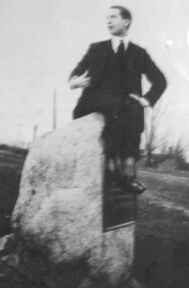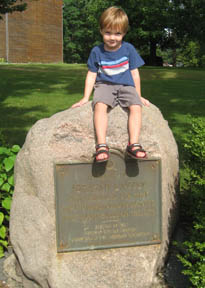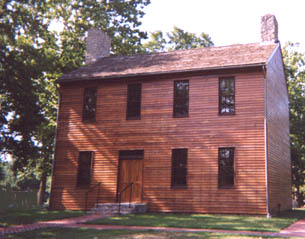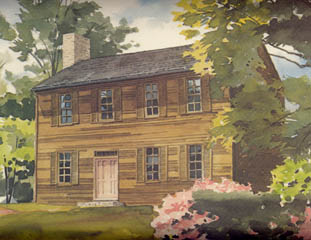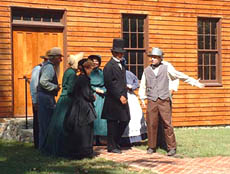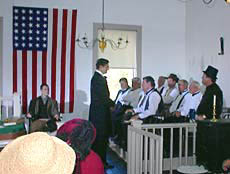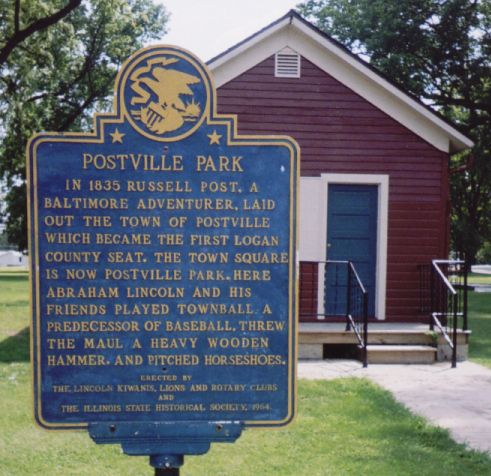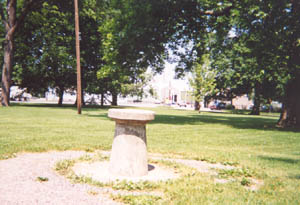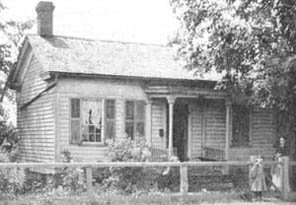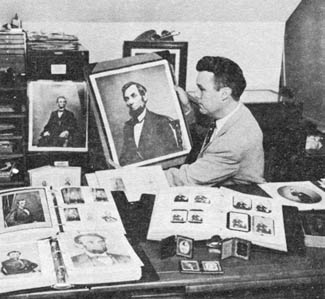
1860 photo taken 4 days after Mr.
Lincoln visited Lincoln, Illinois, for the last time. Info at 3 below.
This President
grew;
His town does too.
Link to Lincoln:
Lincoln & Logan County Development Partnership
Site
Map
Testimonials
Abraham Lincoln Bicentennial Commission of Lincoln, IL
|
Email a link to this page to someone who might be interested. Internet Explorer is the only browser that shows this page the way it was designed. Your computer's settings may alter the display.
April 24,
2004: Awarded "Best Web Site of the Year" by the Illinois State Historical
Society
|
|
|
Marquee Lights of the Lincoln Theater, est. 1923, Lincoln, Illinois |
|
|
|
1. Abraham Lincoln and the Postville Courthouse,
by Darold Leigh Henson, Ph.D. |
|
"Riding along on my bicycle, I used to send a folded copy of the Lincoln Evening Courier sailing in the general direction of the front door of an unpainted two-story frame building that I knew had once been used as a courthouse. A Negro family lived in it, which seemed only proper since the Great Emancipator had practiced law there."
William Maxwell, Ancestors
(1971), p. 137. This Page Is Dedicated to the Memory of Lincoln Historian James Hickey
1.1: James Thomas Hickey (1922-1996) (Photo from The Lincoln Newsletter (fall, 1996), a publication of the Lincoln College Museum)
1.2: James T. Hickey Signature James T. Hickey signature is from Leigh Henson's copy of The Collected Writings of James T. Hickey (Springfield, IL: The Illinois State Historical Society, 1991). During my freshman year at Lincoln College (1960-61), I took a course titled Lincoln Literature from Mr. Hickey for two semesters. He commuted from his home in rural Elkhart and took time from his job as the curator of the Lincoln Collection at the Illinois State Historical Library to teach just this one course at Lincoln College. Mr. Hickey was a protégé of Judge Lawrence B. Stringer, who studied Abraham Lincoln's life in central Illinois and who wrote the comprehensive History of Logan County, Illinois, 1911, including a chapter titled "Abraham Lincoln." Being a student in Mr. Hickey's class was a wonderful privilege and pleasure, for he taught with authoritative knowledge of Abraham Lincoln and enthusiasm for his subject. In addition, he spoke in the Lincoln tradition of telling humorous stories. He taught with a charming wit that no words can describe, heightening my interest in Abraham Lincoln, local and Illinois state history, and the Civil War. Mr. Hickey co-authored one of the key sources used to develop this Web page: "Courthouse in 1840 Was Most Imposing Building in County," Lincoln Evening Courier. Centennial Edition, Section Six, August 26, 1953, p. 1. More information about James Hickey appears in this Web site on the page titled "A Tribute to the Historians and Advocates of Lincoln, Illinois," whose link appears in the Works Cited below. Since Mr. Hickey's passing, his wife, Betty, has worked in historic preservation in Elkhart and Mt. Pulaski and has become a major benefactor of the Abraham Lincoln Library and Museum.
Lincoln, Illinois, is proud of its several
sites relating to Abraham Lincoln, and the most visible is the
Postville
Courthouse. It is a state historic site located on
Fifth Street, formerly Business Route 66.
· The Rise of Mr. Lincoln from
Surveyor to
Legendary Lawyer in Logan County |
|
|
The Rise of Mr. Lincoln from Surveyor to Legendary Lawyer in Logan County Before Abraham Lincoln was a lawyer practicing at the Logan County Courthouse in Postville and Lincoln, Illinois, he lived in New Salem (a few miles northwest of Springfield, Illinois) and studied surveying, as he tried various ways to earn a living. Mentor Graham, Lincoln's teacher in New Salem, describes the context for this instruction: "In the month of February, 1833, Mr. Lincoln came to live with me and continued with me about six months. It was here that he commenced the study of grammar with me. I was then teaching school. I taught him the rules of surveying. I do not think that Mr. Lincoln was anything of a mathematician--especially so of geometry and trigonometry--before he came to my house and I think I may say that he was my scholar and I was his teacher" (Kunigunde and Nickols, Mentor Graham, p. 128). Note: "by late 1878 Graham had gone to live with his son, Harry L., at a McLean Street address in Lincoln [Illinois], 'across from the old Latham place'" [the Latham house (demolished) was just north of Latham Park, one block north of the Logan County Courthouse square] (Mentor Graham, p. 231). In 1836, Abraham Lincoln completed a land surveying project near Rocky Ford on Salt Creek, just a few
miles west of Postville. In this vicinity on June 16, 1836, Lincoln
platted a town to be called Albany. "Salt Creek divided this site and
gave it excellent drainage" ("'Daddy' Rankin and Band Were Popular Here,"
Lincoln Evening Courier, August 26, 1953, p. 14). No community, however, was established there
(Beaver, History of Logan County 1982, p. 56). "So far as is
known, the only building erected was the Rock House (still standing) [in
1953, but since razed] which was to have been the railroad station"
("'Daddy' Rankin. . . ," p. 14). |
|
|
1.3:
Lloyd Ostendorf Drawing of (From Adin Baber's |
1.4:
Lloyd Ostendorf Drawing of (From Adin Baber's |
|
Note: Lloyd Ostendorf (1921-2000) was a multi-talented, prolific artist and scholar. He had a professional background in surveying, and this expertise enabled him to draw the above images of Lincoln as a surveyor with authenticity. For information about Ostendorf's expertise in surveying, see the link below in Sources Cited. Also, Lloyd Ostendorf was allegedly the greatest scholar of Lincoln photographs (Lincoln's Photographs: A Complete Collection -- the definitive source). A photo of Mr. Ostendorf with some of his collection of Lincoln photographs appears toward the bottom of this page. Mr. Ostendorf had received an honorary Doctor of Humane Letters from Lincoln College some time in the 1950s or 1960s during the administration of Raymond Dooley. At Rocky Ford, near the proposed town of Albany, "a giant grist mill became one of Logan County's first enterprises" (Beaver, p. 56). This structure was known as Rankin's Mill, and it stood until early in the 20th Century. Photo 1.5 below shows Lloyd Ostendorf's drawing of Lincoln crossing Rocky Ford on Salt Creek near this mill. Here, Salt Creek flows across a rich vein of limestone, and Mr. Rankin is seen standing on the flat limestone rocks that formed this "rocky ford." Edmund Rankin, a Logan County pioneer who come from Delaware in 1836, first raised cattle and hogs, sometimes driving up to 1,000 hogs to market in St. Louis. After he was married (in the Postville Courthouse), he lived in a log cabin at Rocky Ford. The Courier article cited above offers this description of his activity there: "In 1851, Mr. Rankin acquired an unfinished mill at Rocky Ford from Leo W. Myers. This mill was within a stone's throw of the town site of Albany. . . . Mr. Rankin made extensive improvements: (1) the stone dam across Salt Creek was raised and strengthened, thereby sending a great volume of water against the huge wooden water wheel which generated the power for grinding the grist; (2) the burrs (commonly called 'lost rocks' or 'niggerheads'), immense rocks found in the neighborhood and weighing about 2,100 pounds each, were shaped for the purposes of crushing the grain; (3) the Rankins introduced the bolting cloth, a great improvement in the art of milling. The total cost of these improvements was about $20,000. The first miller was David Haines. The mill was a busy place in its day and required three millers when run steady day and night. Often times as many as twelve and fifteen teams were waiting for their grist. A number of teamsters would bring their lunch baskets and stay all night. Besides furnishing flour and meal, the place was noted for fish, as many as 800 pounds being caught in one night, the largest weighing 92 pounds. For 30 years, the mill ground to its capacity and as the road and ford were on the main traveled way, it became famed to travelers" ("'Daddy' Rankin and Band Were Popular Here," Lincoln Evening Courier, August 26, 1953, p. 14). Apparently the Rankin Mill site was a popular gathering place for farming families throughout this part of Logan County. In her memoirs, Tildy Kiest Heitmann describes growing up on a farm just west of Lincoln, Illinois, in the 1800s, and her recollections include the following undated account: "We were invited to a fish fry at Rocky Ford. Every family brought a basket dinner. The thing that made a dent in my memory was Daddy Rankin's mill and the water pouring over the dam; at that time the mill was still in use. On our way we drove along Mr. James Beaver's pasture and there were such a lot of horses. Years afterward they had a sale and it was said that some of the horses were over eight years old and hadn't had a halter on yet" ("Growing up in Nineteenth Century Logan County." ILLINOIS Magazine, November, 1977, p. 34). Note: these memoirs were edited by Tildy Kiest Heitmann's daughter, Mrs. Dorothy Trapp of Lincoln, just before Mrs. Trapp passed away. Also, James Beaver, whose pasture and horses are mentioned, may have been of the family whose house is pictured below at 1.8 as that property is known as the old Beaver estate. The Courier article cited above claims the Rankin Mill was "swept away in the flood of October 1, 1911"; yet that conflicts with 1.6 below. Today Salt Creek still flows across this bed
of limestone rock, as seen in photo 1.7. From World War II to the
present, this limestone has been aggressively quarried. For more information, see
28. Mining Coal, Limestone, & Sand & Gravel; Lincoln Lakes; &
Utilities. |
|
|
1.5:
Lincoln Crossing Salt Creek at (Lloyd Ostendorf drawing, from
Beaver, History of Logan County 1982, p. 56) |
1.6:
Rankin Mill Ruins and (Gleason, Lincoln: A Pictorial History, p. 13) |
|
Note: The bridge
in the above photo at right
was familiar to those who roamed Logan County roads in the Route 66 era,
including "ham radio operator at large" Mike Hamilton, LCHS Class of 1958,
and me, his eager passenger-guest. A driver approaching the bridge as
seen in the photo would travel on the Rocky Ford road a few miles east and
then encounter Route 66 just a couple of miles south of the Route 66 Salt
Creek bridge. In the creek photo below, the surface limestone produces white
water (rare in central Illinois) and forms the flat, table-top-like
shoreline seen at the right in the photo. |
|
|
1.7: Salt Creek at Rocky Ford South of Bridge Looking North Toward Rankin Mill Site (Photo by Leigh Henson, 12-02) |
1.8: 19th Century Landmark Near Rocky Ford: the Old Beaver Estate (Photo by Leigh Henson, 12-02) |
|
The town of Albany, which Lincoln surveyed, was located on both sides of Salt Creek at Rocky Ford. Abraham Lincoln's law practice took him to Postville, Illinois, in Logan County twice a year from 1839 to 1847, when he went to Washington, D.C., as a congressman. After Lincoln returned to Springfield from Washington, he continued to practice law on the circuit through the 1850s. On the vast 450-mile-long Illinois Eighth Judicial Circuit in the mid 1800s, lawyers and judges typically rode on horseback or in buggies to go from one village-based court to another, traveling about 35 miles per day through bad weather, swollen streams, and quicksand-like mud (Thomas, Abraham Lincoln, p. 93).
1.9: Lloyd Ostendorf Painting of Circuit Rider Lincoln at the Postville Courthouse Note: The above image appears on a placemat that most likely had been used at the Rustic Inn in Lincoln, Illinois, when it was operated as a restaurant by Jackie Sheridan in the 1970s. The image was taken from the art work of Lloyd Ostendorf. The bottom of the placemat says the original was located at the Lincoln Savings & Loan Association at 111 N. Sangamon Street. My (incomplete) understanding is that the assets of this institution are currently the property of the State Bank of Lincoln of the same Sangamon Street address. My stepmother and collaborator, Judy Henson, acquired this placemat and others in this collection at a yard sale in the spring of 2003. She was kind enough to let me borrow several placemats so I could include their images in this Web site. Lincoln Biographer Benjamin Thomas describes Lincoln's life riding the Eighth Judicial Circuit: "Traveling the long slow miles on horseback with a volume of the Revised Statutes. . . along with an extra shirt and a change of underwear, Lincoln had ample time for contemplation. . . . Frequently he must rise before dawn and ride all day in order to reach the next court on time. . . . The blustery winds that swept the open prairie in early spring and late autumn, sometimes bringing sleet or snow flurries, caused the young lawyer to hunch his shoulders, lower his heard, and pull his heavy shawl closer about him. . . . Heavy showers overtook him on the prairie far from shelter; he might ride all day in drizzling rain. When floods swept away the bridges, he had to swim his horse across the swollen streams" (Thomas, Abraham Lincoln: A Biography, p. 93).
Did Lincoln ride horseback in his early years traveling the Eighth Judicial
Circuit (early 1840s) and then use horse and buggy in his more lucrative
later years (mid- to late 1850s)? Were bridges better established in
the late 1850s that would allow more horse and buggy travel? To what
extent did Lincoln travel by train in central Illinois on legal and
political business? |
|
|
1.10: Bronze Statue of Lincoln the Circuit Rider in Lincoln's Tomb, Springfield, Illinois
(Photo by Pat Hartman, |
1.11:
Lincoln Traveling the Eighth Judicial Circuit |
|
The above photo at left depicts Fred M. Torrey's bronze statue titled Lincoln the Circuit Rider, added to the tomb in 1930-31. (Toward the bottom of this page is a memoir of the Lincoln Tomb.) In 1848, the county seat was moved to Mt. Pulaski and then re-located to Lincoln, Illinois, in 1856. Throughout this period, except for his time in Washington, D.C. (1847-1849), Mr. Lincoln continued to visit this area, especially the city to which he gave his own name, on legal, personal, and political business. From 1856 to his
Presidential election in 1860, Mr. Lincoln practiced law at the Logan County
Courthouse in Lincoln, Illinois. During this four-year period, he even
occasionally substituted for Judge David Davis, who became a fellow
Republican and political ally (Davis was a key figure in getting Lincoln the
Republican Presidential nomination in 1860). Today, the
Logan County Courthouse Historic District includes several sites relating to Abraham Lincoln's
various activities in his namesake town. See
3.
The Transformation of Abraham Lincoln and the Founding of Lincoln, Illinois,
Also the Founding of Lincoln College, the Plot to Steal Lincoln's Body,
and Memoirs of Lincoln College and the Rustic Tavern-Inn. |
|
|
The Deskins Tavern: Site of the First Logan County Court Sessions In Postville, Logan
County court was first held at the Dr. John Deskins Tavern,
two blocks east of Postville square (then and now Postville Park). Here, in 1836 Deskins,
also the sheriff, had built a one-story residence and tavern, adding a second story in
1837. Then, in 1840, the Logan County Courthouse was built in Postville
across the street from the tavern (Gleason, Lincoln: A
Pictorial History, p. 11). |
|
|
After the Postville Courthouse was built, Lincoln, other lawyers, litigants, and judges stayed at the Deskins Tavern, taking meals and socializing. In "off hours" court participants and observers sought entertainment. "Mostly the attorneys had to amuse themselves, and according to Herndon [Abraham Lincoln's law partner], they engaged in 'fights--foot and horse races--knockdown--wrestling--gambling etc.' Whiskey, he noted, 'was abundant and freely used'" (p. 106). After the evening meal, a local "circus or lecture" might provide entertainment, but time for fireplace conversation was abundant. "When that happened, Lincoln, of course, was a center of attention, and as Herndon remembered, 'Judges--Jurors--Witnesses--Lawyers-merchants, etc etc have laughed at these jokes. . . till every muscle--nerve and cell of the body in the morning was sore at the whooping and hurrahing exercise'" (David Herbert Donald, Lincoln, p. 106). Did Lincoln Sleep Well at the Deskins Tavern? "An incident connected with Lincoln's stopping at the old Postville tavern, is thus told: At one time Lincoln came to Postville from Springfield, in company with Judge Treat, the two riding in Judge Treat's buggy. The occasion was a special term for the trial of a criminal. Treat and Lincoln
stopped at the Deskins tavern. After they had gone to bed and everybody
about the hostelry was asleep, there came a terrific pounding at the door.
The landlord got up to let in the energetic assailer of the portal, who
seemed to be assiduously in search of a drink of whisky and was in the
parched condition of the traveler in the Sahara desert, to whom delay is
intolerable. |
1.12: Deskins Tavern Historical Marker (Photo by Leigh Henson, 8-7-03) This marker is in front of the VFW Building on Fifth Street (Business 55, formerly Business Route 66) across from the Postville Courthouse Historic Site. |
|
The landlord explained
that he had no whisky in the house, whereupon his visitor wanted to know if
he couldn't get it at some tavern or store. Wasn't there any place in the
village where a drink of whisky could be had? To all these questions the
landlord returned a negative and as the full horrors of his whiskyless
situation burst upon him, the fellow said with emotion, 'Great Heavens! Give
me an ear of corn and a tin cup and I'll make it myself." Lincoln and
Judge Treat listened to this colloquy with great amusement, and the next
morning Lincoln asked the landlord what had become of his guest. 'Oh,' he
replied, 'the fellow left before daylight.' In after years, Lincoln
frequently told this story to amused auditors and he always laid the scene
of the anecdote at Postville" (Stringer, p. 216). |
|
|
1.13: The Deskins Tavern-Hotel (Dooley and Welch, p. 6) |
1.14: Judge Samuel H. Treat (Dooley and Welch, p. 9) |
|
Stringer describes the Deskins Tavern-Hotel:
"The doors, sashes, and stairs of this hotel were made by George W. Edgar
and it was weatherboarded with black walnut from Orendorff's mill." The
building was razed about 1900 (Stringer, p. 563). A VFW post now occupies
the site. |
|
|
Lincoln gained much professionally and personally from his experiences on the circuit, which also increased his interest in and talent for politics. Benjamin Thomas writes, "During political campaigns, in the late afternoon when court had adjourned, or at 'early candle-light,' the lawyers entertained and edified the citizenry with speeches or debates. A popular lawyer like Lincoln, bent on a political career, could acquire a formidable following among acquaintances and admirers on the circuit. . . " (Thomas, Abraham Lincoln, p. 94). Benjamin Thomas
continues his assessment of the circuit experience in shaping Lincoln's
political abilities: "It was an educational process, too. No
profession offers such insights into human nature as does the law, while in
the give-and-take of discussion in these rural forums Lincoln observed the
development of political issues and the formation of public opinion on men
and measures. Here was a training-ground on which he further developed
his political astuteness, learning the thought-processes of the people and
how they might be guided, when to speak and when to maintain silence, what
to say and how to say it" (Thomas, Abraham Lincoln, p. 94). |
|
|
Preserving the Well of the Deskins Tavern In front of the Deskins Tavern and across the street from the Postville Courthouse State Historic Site is a landmark well, built in the early 1840s. This well was the only one in the area, and so historians indicate that court participants, including Abraham Lincoln, obtained water from it. The well is 34 feet deep and was constructed in three sections. Two sections were lined with brick, the third lined with curved pieces of cedar. In the spring of 2003, restoration was underway, including a new wooden platform and hand pump replica, to show the way it appeared for many decades. The dedication of the well is planned for the first day of the sesquicentennial celebration on August 24, 2003. More information about the well and its restoration appears in "Well Restoration Brings Back Local History," an article in lincolndailynews.com, February 21, 2003 (link below in Sources Cited).
1.15: Restored Pump at
the Historic Well at the Former Deskins Tavern Site (Photo by Leigh Henson, 8-06) Note: The restored pump is in front of the present VFW Building. The earlier photo below, from 2003, shows the pump soon after its restoration.
1.16: Newly Restored Pump in 2003 (looking west toward Postville Park)
Note: The trees
in the far background at the left are in Postville Park. The green
building in the center background is the V. Goodman Transfer & Excavating
Company, and behind Goodman's is the building that had housed Big Al's
Restaurant, which was formerly the site of the Wilson Grocery and Shell gas
station in the Route 66 era. A new Casey's is at the right, and this
was the site of a general store in the 1840's (the more things change, the
more they stay the same?). |
|
|
A History of the First Logan County Courthouse (Postville Courthouse, 1840) |
|
|
The Postville Courthouse of Logan County was built in 1840. It "was one of the most pretentious centers of county justice in the state. There were few two-story buildings in Illinois at that time" (Fish, Illustrated Lincoln, no page numbers used). The construction of the Postville Courthouse resulted from the land speculation activities of several investors, including Russell Post and Seth Tinsley. "Postville in 1836 was a city containing over one hundred and fifty blocks--at least, on paper" (Hickey and Bolt, p. 1). Yet, the depression of 1837 interfered with development. Meanwhile, some state
legislators were interested in dividing Sangamon County, which in their
opinion was too large. In the state legislature, Lincoln was
chairman of the committee on counties and favored the formation of Logan
County from the northern section of Sangamon. |
1.17: Early Photo of the
1840 (Photo in Dooley and Welch, p. 6) What is the tall white image at the left? Is the outbuilding in the right background an outhouse? |
|
Tinsley and his partners saw an opportunity to advance their real estate development and so offered to provide the land for a county courthouse at Postville and even build it. Their offer was accepted by the State of Illinois when Logan County was created in 1839. The Construction of the Postville Courthouse Across the Street from the Deskins Tavern Historians James T. Hickey and Roger Bolt describe the construction: "Tinsley himself supervised the project. He hired one Peter J. Cowardin to build the structure. Its dimensions turned out to be 28 feet by 38 feet. The stone for the foundation had to be brought from Rocky Ford five miles to the west since the deep prairie sod had buried rock far below the surface. Walnut siding and oak timbers were brought to Postville from the mill of the Orendorffs, Germans from North Carolina who lived on nearby Salt Creek. This part of the county seat bargain cost the proprietors, according to Tinsley, $1,176.83" ("Courthouse in 1840 Was Most Imposing Building in County," Lincoln Evening Courier, Centennial Edition, Section Six, August 26, 1953, p. 1). Henry Fish in 1916 describes the Postville Courthouse: "The original masonry and walnut timbers in the building stand today [1916], a monument to the sturdy pioneers who erected them." The Construction of the First Logan County Jail Northeast of the Courthouse Near the time of the completion of the courthouse, a jail was also built near it. An account of this building appears in History of Logan County 1886: (Curiously, this source describes the construction of the jail but not the courthouse.) Apparently the jail was not located on the courthouse square, but "some distance northeast of the court-house square. . . . This jail was about twelve feet square, and that many feet in height to the first story. The upper floor was made of logs of the same dimensions as those composing the sides, securely fastened to the upper tier of logs. The lower floor was composed of logs hewed about twelve by sixteen inches in thickness, the greater thickness placed upward. These were laid closely together, and, as well as the walls and upper floor were covered with heavy oak plank, two inches in thickness, thoroughly nailed on, within and without. In the center of the upper floor a small trap door was made, sufficiently large to admit a man's body. In order to secure light and ventilation, this door was composed of a crosswork of iron bars, firmly fastened together, and secured with a good padlock several inches from the floor. Two windows, of similar material, were also made. over all a good, heavy roof was placed, and in the end of the upper story a door was made of heavy plank, which in turn could be securely bolted. When a prisoner was confined within this citadel, he was, in most cases, safe. he would be taken in at the upper door, the trap-door of the inner cell raised, a ladder let down, and he was compelled to descend into the prison. The ladder would then be withdrawn, the trap-door and outer door bolted, and he was safe. It is confidently affirmed that criminals could more easily escape from the jails of today than from this one" (p. 223). The 1886 History of Logan County then presents 1 1/2 pages describing the confinement, escape, and pursuit of a man named Bartlett, who was recaptured when he was discovered mostly submerged in Salt Creek to conceal himself from his pursuers. When the Postville Courthouse was sold in 1848 to Solomon Kahn, "the jail was also sold, and the logs comprising its strong floor and sides were used for ties on the railroad" (early 1850s, when the predecessor of the Chicago and Alton Railroad brought about the founding of Lincoln, Illinois). I have often thought that it would be a worthwhile project to build a replica of this jail on the northeast corner of the present-day Postville Courthouse replica site. The Postville Courthouse
also served as a community center. "It was a church and public
hall. Peter Cartwright, the circuit evangelist, held a series of
meetings here. Here, too, the Logan
County company which volunteered for service in the Mexican War, met in June
1846 and marched out, with band playing, down Salt Creek Hill [Cemetery
Hill] en route to headquarters at Alton, whence they embarked by water for
Vera Cruz" (Fish, Illustrated Lincoln, no page numbers used). |
|
|
1.18:
Picture Postcard of the Original |
1.19: Undated
Picture Postcard of the |
|
Picture postcards were commonly used during the Route 66 era before
and after the
Postville Courthouse replica had been constructed. |
|
|
Questions Probed About the Postville Courthouse Chimneys In writing this history of the Postville Courthouse and its replica for this community history Web site of Lincoln, Illinois, I encountered what appeared to be contradictory information about the number of chimneys on the original courthouse, constructed in 1840. In his History of Logan County (1911), Lawrence B. Stringer writes of the Postville Courthouse that "a fire-place, with its picturesque outside fireplace chimney, gave heat to the building when required" (p. 154). The 1930 reconstruction of this courthouse in Henry Ford's Greenfield Village near Dearborn, Michigan, and the courthouse replica in Lincoln, Illinois, constructed in 1953, both have exterior, two-story stone fireplace chimneys on their left walls. Yet, all of the several published photos of the original courthouse, the earliest dating to near the beginning of the 20th century, clearly show the left wall without such an outside chimney. Instead, the earliest photos of this building (for example, #1.17 above) show two brick chimneys, and they are recessed from the ends of the roof peak on either side. Clearly, those chimneys arise from the interior of the building. The
photo below (left) of the Postville Courthouse reconstruction in Greenfield
Village shows a fully exterior fireplace chimney on the left side. Yet,
an undated, early photo of the left side of the original Postville
Courthouse clearly shows a window toward the back of the left side, but no
exterior chimney from the ground up (photo below, right). |
|
|
1.20:
Postville Courthouse Reconstruction with Ground-up Fireplace Chimney (undated Courier photo, 8-1953) |
1.21:
Original Postville Courthouse Without (photo in Gleason, p. 12) |
|
If the
original Postville Courthouse had an exterior fireplace chimney from the
ground up, what happened to it? (In my various sources of history, I find no
reference to its removal or destruction.) If the original courthouse did not
have a chimney fireplace from the ground-up, was it a revision of history
fabricated when the courthouse was reconstructed in Greenfield Village,
Michigan? Did this fabrication then serve as the model for the design of the
replica that was built in Lincoln, Illinois, in 1953 as seen in 1.19 above?
Or, is there some other answer to the question of the exterior fireplace
chimney? |
|
|
The only image I find that suggests the left chimney might have been on the exterior from the ground up appears opposite of this passage. That image is from a painting in the contemporary Logan County Courthouse, completed in 1905 (artist unknown). Did this image give Judge Lawrence Stringer the idea that there was an exterior chimney, as he reports in his 1911 History of Logan County? If not, what other evidence is there for Judge Stringer's reference to an exterior chimney? The
architectural firm of McGuire Igleski & Associates, Inc., of Evanston, IL,
designed the replica. This firm's Web site has an interior photo of the Postville Courthouse
replica's fireplace constructed of brick:
http://www.miarchitects.com/governmental5.html.
Now was brick the authentic material? If there really had been an exterior
stone chimney, would not the interior fireplace also have been built with
limestone as the foundation and chimney were? |
1.22:
Postville Courthouse with One Chimney, Photo by Jan Youngquist |
|
Also, note the absence of a right-side chimney in the Michigan reconstruction (1.20) in accordance with the absence of a right-side chimney in the painting of the 1905 Logan County Courthouse (1.22). The most convincing evidence to cast doubt on the external, "ground-up" chimney design is a drawing of the original Postville Courthouse found in History of Logan County 1886. This drawing could very well be the oldest representation of this building, capturing its authenticity:
1.23: Unidentified Artist's
1880s Rendering of the (drawing in History of Logan County 1886, p. 222) In
August of 2009, I wrote to the Benson Ford Research Center of the Henry Ford
Museum because I had reason to believe its archives held photos that could
answer my questions. In an article titled "The Postville Courthouse
Revisited," published Feb. 12, 2002, in LincolnDailyNews.com (see link below
under Sources Cited), Stan Stringer (no relation to Lawrence B. Stringer)
had mentioned that Henry Ford's "conservationist hired my father, Charles M.
Stringer, to photograph the disassembly of the courthouse." Charles
Stringer, a professional photographer, had a studio in downtown Lincoln on
Broadway Street in the 1930s and '40s. The Benson Ford Research Center
informed me that I would need to pay for a minimum of one hour of research
($35.00) for them to see whether the photos in question were in their
archives. I sent the payment and subsequently received a letter and
photocopies of thirty stunning, black-and-white photos. Most of these are
stamped "Stringer Lincoln, Ill." on the back. Two of these photocopies show full views of the left (west) side of the original Postville Courthouse in 1929. They show a chimney above the peak of the roof, and the chimney was an interior structure. The photos, however, also prove that the left-side wall once had a large, external two-story chimney that at some time had been removed and the large hole replaced with boards. These replacement boards are approximately the same width as the other siding boards and aligned with them at the edges of the hole. The edges of the abutting replacement boards form a distinct outline (pattern) of the external chimney that was part of the original 1840 structure. This outline shows the shape and contour of the chimney whose upward sides gradually narrowed. This outline is reflected in the design of the external chimney featured in the reconstruction at Greenfield Village and the replica in Lincoln. The photos also show a window on the left wall that had been built after the original chimney was removed. The photos show a door on that wall with a cat sitting on the doorway steps.
Thus, the external stone fireplace chimney on the Postville Courthouse replica is accurate to the original, but the chimney on the ride side probably is not, just as the brick fireplace of the replica is not accurate: if the original chimney was constructed of limestone, it follows that the fireplace was likewise built with limestone. The original limestone fireplace chimney disappeared (was removed/) some time before publication of the 1886 Logan County History, which has the drawing of the building without its original chimney. The original fireplace and chimney were replaced with a brick fireplace and interior chimney. My good cousin Lincolnite Keith Leesman is a fellow history buff and volunteer at the Postville Courthouse State Historic Site (replica). He tells me he saw file information that says the original Postville Courthouse at some point was moved forward off its limestone foundation. Stringer's photos in the Benson Ford Research Center collection show the new foundation was brick. Some of those photos also show that the original stone foundation had been excavated when the courthouse was dismantled, and that foundation is clearly pictured. I suspect Ford's men took everything they could with them to Greenfield, including the original limestone foundation. Keith suggests that the perhaps the new brick fireplace and chimney were built when the courthouse was moved forward, and that makes sense to me. A corresponding brick, interior chimney was constructed on the opposite wall (east side). We are still in search of the date when the courthouse was moved forward onto its brick foundation. My friend Jesse Hoots has restored historic buildings for forty years, and he assures me that an interior brick chimney provided a better heat source than the external stone chimney. My speculation is that the Postville Courthouse was moved forward onto the brick foundation in the 1870s to early 1880s just before the 1886 courthouse drawing showing the absence of the exterior stone chimney. Lawrence B. Stringer writes that "connected with the company [South Coal Mine] is an extensive tile factory, which has been operated since 1878" (p. 542). Access to clay for the tile and bricks made there resulted from digging mine shafts. Somewhere I read that this brick and tile factory was begun in order to provide work for the miners during the winter. My father, Darold Henson, many years ago when I was growing up in Lincoln in the 1950s had told me of an area called "the clay banks," just south of the Lincoln State School (later named the Lincoln Developmental Center) and just east of New Union Cemetery. That area is a depression in the surface where the factory must have dug to obtain its clay. Both Dad and I played in "the clay banks" as kids, and that depression still exits today, overgrown with scrub trees. I find little published information about the brick and tile factory. The centennial edition of the Lincoln Evening Courier contains an undated photo of men and boys employed at the brick yard (August 26, 1953, p. 10). The caption of the photo identifies the location of the brick yard as the site of the house provided for the superintendent of the Lincoln State School. During some years of the Route 66 era, that house was the home of the Dr. William Fox family, whose son, Bradley, was my classmate at Jefferson School, Central School, and Lincoln High. Gleason's Lincoln, Illinois: A Pictorial History has a picture captioned "The 1870s brickyard crew of the old South Mine" (p. 33), and this photo is different from the one in the Courier. Into his 90s, Willie Aughton gardened in the south Lincoln area just a couple blocks north of the site of the former brick factory, and he says he finds a lot of broken bricks in the surface soil there. The area was probably a dumping ground for broken brick. The following photo is published here after I paid a user fee of $30.00 to the Benson Ford Research Center.
1.24: 1929 Photo by Charles
M. Stringer Photo #973 from the collections of The Henry Ford; copy and reuse restriction apply. Ref: http://www.TheHenryFord.org/copyright.html. http://www.thehenryford.org/imagesourceterms.aspx. At the time this photo (previously unpublished) was taken, the property had been occupied by tenants using the building as a residence. Notice the cat sitting on the top step. In his online article titled "Postville Courthouse Revisited" (link below under Sources Cited), Stan Stringer writes, "As my father told me, when Ford bought the courthouse, it was rented to a poor family. Ford generously brought the family to Detroit, and Ford Motor Company hired the father at the wage of $5 a day. While this now seems pitifully small, in 1929 and during the Depression it was top dollar for factory workers. As a postscript, Dad later told me the family that Ford moved to Detroit returned to Lincoln a few years later. They missed the rest of their extended family in Lincoln, and $5 a day was just not reason enough for continuing the separation."
|
|
|
The Honest Abe of Postville: Mr. Lincoln Handles Two Cases of Guilty Clients Lincoln's professional and social activities in Postville and later in the town named by and for him established the foundation for the Lincoln legend in this community. The following two cases at Postville in which Mr. Lincoln's clients were guilty show his moral compass.
Mr. Lincoln's Client Who Was
Guilty of Deceptive Practice |
|
|
One case, first described by Judge Parks and later verified by "other old settlers," supposedly happened in the Postville court in 1843. In a trial, evidence was produced that showed Lincoln's client "had deceived him and was in reality trying to collect the note a second time." After recess, Lincoln was not in court and was discovered by Sheriff Deskins in Postville Park playing ball with the boys. Lincoln reportedly said he had left to clean his hands. When Judge Treat heard this, he supposedly said, "Honest Abe." Judge Stringer then concludes, "It is more than likely that the later term, "Honest Old Abe," originated here (Stringer, p. 217). Judge Stringer undoubtedly was sincere and hopeful that the slogan of "Honest Old Abe" had originated from this episode, but most likely Judge Treat was merely repeating a description of Lincoln's reputation. Benjamin Thomas, acclaimed to be the most authoritative Lincoln biographer of mid-Twentieth Century, attributes the origin of the "Honest Abe" nickname to Lincoln's experiences in New Salem in the 1830s, several years before Lincoln practiced law on the Eighth Circuit:
"People [in the New Salem area] recollected his honesty and kindness. In
making change for a woman, while working in Offutt's store, he took out six
and a quarter cents too much and at closing time, discovering his error,
walked six miles to return the money. |
1.25: Alleged First
Photo of (Showing him as he looked in the early years of his business in Lincoln, Illinois. Photo in Benjamin Thomas, Abraham Lincoln: A Biography, 1952. Known as Meserve #1, this photo dates to 1846-47, according to the Lincoln Research Web site: address below.) |
|
On another occasion, after weighing out some tea, he found a four-ounce weight on the scales, and again walked several miles to correct his mistake. Such acts as these won him the nickname "Honest Abe" (Benjamin Thomas, Lincoln's New Salem, p. 145). These are the kinds of stories I remember Logan County Superintendent of Schools E.H. Lukenbill telling when he visited Bernadine Jones's classes at Jefferson School in the early 1950s.
During the Lincoln, Illinois, Centennial Celebration, Lincoln College
awarded Lincoln Biographer Benjamin Thomas an honorary degree of Doctor of Literature. A
Courier photo of this ceremony shows a large sign in the background
indicating that WBBM (CBS) had broadcast this event ("Receive Degrees. . ," Lincoln Evening Courier, September 2, 1953, p.
9). WBBM
had its beginning in Lincoln, Illinois, before moving to Chicago (for more
information about WBBM, see
31.
News Media in the Route 66 Era). |
|
|
Mr. Lincoln's Client Who Was Guilty of Stealing a Horse The following story is attributed to Mrs. P.H. Peifer, who says her Grandfather John Jenkins had told it to her: "In the early days when traveling was done mostly on horse back, horse stealing was considered almost as great a crime as murder. Court was in session in the then new court house in Postville where Mr. Lincoln from Springfield, just admitted to the bar, was to defend a young man arrested for horse stealing. The day was exceedingly hot and, after court had been called to order and the preliminaries were over, Mr. Lincoln said, 'Boys, let's go out under the shade of that apple tree and try this case if your Honor, the Judge, will allow.' So each took his chair and the clerk his book and they went out. It was not hard to prove that the young man took the horse. He did not deny it. Everything pointed plainly to a long term in the penitentiary. There was silence when Mr. Lincoln got up to present his case. 'Your Honor,' he said. 'Will you permit me to change the usual order a little?' Then to the prisoner he said, 'Young man, you did take the horse, you know. Now stand up and tell the Judge how you came to do it. Tell him just as you told me.' Rising, the prisoner said, 'Your honor, I am not a thief, nor did I intend to steal the horse, but I had just received word that my wife was very sick and my little baby, whom I had never seen was dead. The only way for me to reach them was to get a fast horse and ride to Springfield in time to get on the train to go down to the Illinois River. I had very little money because I was earning only $12.00 per month. The man I was working for I knew would not lend me the horse and I didn't know what to do!' But your Honor, I had to get home. So after dark I put a bridle on the horse and started for the Springfield railroad office. When I got nearly there, I took the bridle off the horse, fed and watered him and started him back to his home. I felt sure he would go home and I had not hurt him a bit. I then took the train and got home in time to bury my little boy and take care of my wife who I believe would surely have died if I had not been there. When she got better, we intended to come back here and try to get some land, but before we got started I was arrested and brought back. You see, Judge, the horse did not go back home but was taken up by some one and I was charged with stealing him.' He sat down. Mr.
Lincoln arose and pleaded his case. He begged Judge Lacy to fine the man and
give him a chance to pay for the horse.
My grandfather, who was clerk of the court, said that no man with a heart
could have refused Mr. Lincoln's appeal and the Judge did not.
Years afterwards when Mr. Lincoln was running for President this man, who
was among the rich and influential farmers of Illinois, worked for him as he
would for a brother and helped to make him President of the United States"
(Dooley and Welch, The Namesake Town, p. 10). |
|
|
Mr. Lincoln's Legal Service to Help Logan County Retain the Postville Courthouse
Lincoln went to
Washington, D.C., in 1847 as a member of Congress, and so did not ride the
circuit for his two-year term. In 1848, the Logan
County court was shifted to Mt. Pulaski, the new county seat. "But
[Abraham] Lincoln was to have one
more opportunity to become involved with the courthouse. In 1849, the
proprietors of the town of Camden and or Postville [Postville had been
temporarily renamed] sought to recover the building and the land which they
had given to the county in 1839, since the building and the landed property
were no longer being used as a the seat of justice. Abraham Lincoln,
again on the circuit after his single term in Congress, defended Logan
County. After a long litigation, the State Supreme Court ruled against
the proprietors" (Hickey and Bolt, p. 1.) |
|
|
The Postville Courthouse as Private Property |
|
|
From the time of its
discontinuation as a courthouse in 1848 to its purchase by Henry Ford in
1929, the Postville Courthouse was used
"for other purposes, including a grocery store, post office, and residence.
. . " (Gleason, p. 12). Kahn was the patriarch of the Landauer family and
the founder of a family clothing business that served Lincoln for
generations. According to the Landauer family history, the Solomon Kahn family lived on
the second floor of the Postville Courthouse. "It is a matter of
family history that when Solomon Kahn was cleaning out the attic of the
courthouse, he found many legal papers and letters written by Abraham
Lincoln. Considering the documents worthless, he burned them as trash"
(Beaver, History of Logan County 1982, p. 386). |
1.26: Solomon Kahn (Photo in Dooley and Welch, Ad for Landauer's Clothing
Store in The Namesake Town, p. 56) |
|
1903: Postville Courthouse Owned and Occupied by John Schoof and His Family
1.27: Photo of the Schoofs
in Front of Their Postville Courthouse Home |
|
|
1.28: Photo Better Showing the Front Porch Added by the Schoofs to the Postville Courthouse (Photo from Paul Gleason, Lincoln: A Pictorial History, p. 12) The following photo is published here after I paid a user fee of $30.00 to the Benson Ford Research Center.
1.29: 1929 Photo of the Postville Courthouse Block from the Corner of Fifth and Monroe Streets This previously unpublished photo was taken by Charles M. Stringer. The photo shows an Illinois Route 4 sign on the far side (looking northwest) of the brick-paved Fifth Street in the year just before Route 4 changed to U.S. Route 66. The brick pavement appears wet, and a puddle of water appears in the left foreground. Also note that Monroe Street was not paved in 1929. Note the D.A.R. Lincoln Memorial Boulder, dedicated July 4, 1917. The pole behind the bolder was probably a flag pole, not a utility pole, which in those days had crosstrees. A news report of the dedication of the Lincoln Memorial Boulder said that there was a flagpole nearby.
Photo #983 from the collections of The Henry Ford; copy and reuse
restriction apply. Ref:
http://www.TheHenryFord.org/copyright.html.
http://www.thehenryford.org/imagesourceterms.aspx. |
|
|
Postville Courthouse Ownership from 1910 to the Present As a result of seeing this page soon after its publication on July 4, 2003, life-long Lincolnite and Civic Leader Les Van Bibber (also one of my good childhood playmates) emailed me that his maternal grandparents had once owned the Postville Courthouse. Les had researched the deeds of this period and emailed the following information of the next two paragraphs on July 9, 2003. Wanting to know more about the Kirks, who were my parents' neighbors from my childhood on Seventh and Monroe Streets, I requested it in early 2007; and Les kindly responded with photos of his Kirk grandparents, the Postville Courthouse in the early 20th century, and of his uncles who were born in the original Postville Courthouse. That material appears below. "Leigh, I dropped off four items at your dad's house yesterday, that I had previously promised you. I delivered a copy of the original or first plot of Postville and three copies of warranty deeds of the Postville Courthouse property. Please note that the plot contains 39 blocks including Postville Park referred to as the "public square" [access the original plat of Postville]. I am mentioning this because you will also note from copies of the three warranty deeds that they also refer to block 61, the lot where the Postville Courthouse was located, as the "public square." The differences, of course, are the different block numbers. The Postville Courthouse, located on block 61, would have probably appeared on the second plot of Postville. You will also note that some of the street names are shown on the plot now have different names." "The three warranty deeds cover all the years from August 11, 1910, when my grandfather purchased it from David and Rachel Andrew for $1,350 to January 21, 1913, when my grandparents, John H. Kirk and Ruby C. Kirk, sold it to Timothy T. Beach, a former judge, and Grace A. Beach for $2,000. Mr. and Mrs. Beach owned the old courthouse until they sold it to Henry Ford and Clara J. Ford, founders of the Ford Motor Company, for $8,500 on September 6, 1929. I believe it is proper to mention that my grandparents used the old Postville Courthouse as a residence and that their two oldest children, William and Travis Kirk, were born at home in the upstairs room now used to represent the courtroom."
Note: Les Van Bibber has also worked as a volunteer tour guide
at the Postville Courthouse Historic Site. Respond to Les at
[email protected].
|
|
|
As
a result of her seeing this page and the Kirk information and photos from
Les Van Bibber, I received the following message on February 1, 2007: I have enjoyed viewing and reading about the history of Postville, and especially your experience growing up in Lincoln. I also was born and raised in Lincoln. I don't know if you remember any of my brothers, but my brother Travis (Augie) is living in Oregon now and he also enjoys your site. My brothers Kenneth and Steven both live in Texas. Kenny passed away in 1994 at age 51 with cancer. The reason I am writing is I would like to send you a picture of my grandparents as they would have looked when they resided in the Postville Courthouse. John Henry Kirk and Ruby Catherine Duke were married April 10,1910 in San Antonio Texas. They purchased the Postville Courthouse on August 11,1910. It's a picture I will always cherish and thought you might enjoy seeing it. I also have a picture of Dad and Uncle William when they were babies, and I also have the same picture of Uncle William you put on your site, but I repaired it. The best I could anyway. Just thought I'd send it. One more thing I noticed in
your remembrance of the Kirk family you mentioned about Uncle Pat being in
the Navy. James Patrick Kirk was in the US Air Force. I hope you enjoy the
pictures and thank you again for your wonderful site.
Below is the wedding photo of the John Henry Kirks kindly provided by Nancy Kirk Wiggers: |
|
|
1.30: 1910 Kirk Wedding Photo (Click photo for cropped close-up.)
1.31: Kirks' Photo of the Original Postville Courthouse When They Lived There (early 1900s) Photo is courtesy of Les Van Bibber. Fifth Street was unpaved. Also note the deck of the porch and outbuildings. According to the Courier photo earlier on this page (1.26), the porch was added by the Schoof family in approximately the first two years of the twentieth century. Also note the outbuildings.
Below are photos of William and Travis Kirk, who were born in the original
Postville Courthouse, as reported above by Les Van Bibber and Nancy Kirk Wiggers. |
|
|
1.32: Kirk
Infants Who Were Born in the Original Postville Courthouse |
|
|
1.33:
Travis D. Kirk (1913--1994) |
1.34:
William J. Kirk (1911--1986) |
|
Les Van Bibber provided the photo below of his Kirk
grandparents: |
|
|
1.35: Ruby C. (1895--1958) and John Henry Kirk (1867--1956) Les Van Bibber reports that his Grandfather J.H. Kirk had built several hundred houses in Lincoln. In an email of 1-30-2007, Les remembers his Grandfather J.H. Kirk: "My grandfather was very bright and very honest. His father was a minister with the Christian Church. My Uncle Ezra Kirk, my grandfather's half brother, told me that their father, my grandfather and my Uncle Ezra's father, carried a Bible with him every hour he was awake. He also said that my grandfather had the best builder's eye of any builder he ever came across. The next time that you return to Lincoln please check out the first home east of the Postville Courthouse on Fifth Street and the same side of street; it is the home my mother Katherine Kirk Van Bibber Orr was born in and where my grandparents had built and moved into after they sold the original courthouse. Then compare how similar but smaller it looks to their final home he built across from your parents' home. He built dormers on both of these homes." [Leigh's note: I remember both houses well, and their extended, notched rafters are a characteristic of the Craftsman school of architecture popular in the 1920s.] Ruby and J.H. Kirk's third child, Henry, became a builder also. Henry Kirk was a project manager of more than a hundred buildings from Paris (Orley Airport) to Casablanca to Chicago and Milwaukee. Perry Harris is a great grandson of Ruby and John Henry Kirk. Perry's mother, Mary Kay, was a daughter of Evie and Henry Austin Kirk, the third son of Ruby and John Henry. Perry provides the following oral family history regarding the Kirks and the Postville Courthouse. Note: Les Van Bibber, a grandson of J.H. Kirk, and someone with a strong interest in Kirk family history, says he has never heard about anything in this anecdote before seeing it here: "Grandpa Kirk sold the courthouse to Judge Beach. He then bought a row of houses in the 400 block of 9th street with the proceeds. The Kirk family tells the story of Henry Ford hiring John Henry Kirk as a consultant when the replica courthouse was erected. Henry Ford supposedly wrote out a check for $700 or $900, drawn on Henry Ford's personal account. Grandpa Kirk (my great grandfather) called members of his family over to his house to show off the check. It's been said that Grandpa Kirk got into an argument about the placement of the courthouse in its present location. The story is that it was originally facing Monroe street, to the immediate east." Respond to Perry Harris at [email protected] Leigh's comment: Family oral history is interesting but may not be supported by published, verified sources. As a result, family oral history may be subject to fact error. For example, even the idea that there may have been some debate over what street the Postville Courthouse may have faced is probably erroneous. The earliest published account of the construction of the Postville Courthouse says that it "was built in the center of the square, faced the south [bold mine], and was two stories high" (History of Logan County, 1886, p. 223). Because the Courthouse faced south, it faced Fifth Street, not Monroe Street. Subsequent histories do not suggest otherwise, so it is highly unlikely that anyone would have debated which street the Courthouse faced. On the other hand, the first Logan County jail was constructed northeast of the Courthouse (as described above) and could very well have faced Monroe Street, which runs north/south on the east side of the Courthouse. Thus, there could very well have been a debate as to which street the jail faced; and if indeed J.H. Kirk argued that the jail faced Monroe Street, his position made very good sense.
In
material provided by Les Van Bibber there is a 1953 Courier photo of
several men looking at the site of the Postville Courthouse shortly before
its replica was constructed. The men are Logan County Judge William S. Ellis,
secretary of the (newly formed) Logan County Historical Society; John Henry
Kirk, former owner of the original Postville Courthouse; Alfred G. Lindblad,
an architect with the state division of architecture and engineering who
conducted a survey of the site; E.H. Lukenbill, president of the Logan
County Historical Society; and Lincoln scholar James Hickey, vice president
of the Society. |
|
|
Leigh Henson's remembrance of the John Henry Kirk family: When I grew up in Lincoln, one block away from the Postville Courthouse site, Ruby and John Henry Kirk lived across Monroe Street from my parents' home on Seventh and Monroe. As a carpenter, Mr. Kirk had built his home there. Les's family lived on Seventh Street, one house west of his Kirk grandparents. I often visited the Kirks' yard in order to taste the mulberries and the leaves of peppermint plants that grew along their driveway. The Kirks' backyard was interesting for its rabbit hutches, sheds with tools, and piles of boards. As I rode my bike on Monroe Street, I was challenged to avoid falling on the slimy mess in the street made by the mulberry trees (and the noxious residue from the blackbirds that feasted on the seedy fruit). The youngest Kirk son, Patrick "Pat" James; Les; his brother, Larry; their cousin Augie; and others in their family often played on the Hensons' backyard basketball court, along with other neighborhood stars, including Karl and Leonard Newton. I recall that when Pat Kirk got out of the Air Force in the1950s, he did tricks on his motorcycle as he rode up and down Monroe Street, including standing with one foot on the seat. John Henry Kirk made wooden stilts for the countless neighborhood children. He also made toy guns that shot giant "rubber bands" that were crosscut sections of car tire inner tubes. I recall that as a kid I tried to duplicate Mr. Kirk's handiwork, and I discovered that I had very limited talent for measuring, sawing, and driving nails into wood. The Kirks and their colorful grandchildren, including Howard and Huck Kirk, along with the Newton neighbors, added much fun and excitement to my experience of growing up in west Lincoln in the 1950s. Ruby and John Henry Kirk and others in their family rest in Old Union Cemetery. For additional information about my childhood experiences with the Kirks and the Postville Courthouse site, including my debates about the old Postville Courthouse with Les's younger brother, Larry, see "Memoir of the 1953 Construction & Dedication of the Postville Courthouse Replica" in the Works Cited below. For more Kirk family photos, access Augie Kirk's Web site (link in Works Cited below). Below is a photo of Judge Beach. He and his wife bought the Postville Courthouse from the Kirks.
1.36: Judge Timothy T. Beach, Co-Owner (with His Wife) of the Postville Courthouse, 1913-1929 (Photo in Dooley and Welch, The Namesake Town, p. 24.) Timothy Tildson Beach was born at Rosendale, New York, in 1843. He served in the Union Army during the Civil War and saw action in the battles of Gettysburg, Rocky Ford, Resaca, Dallas, Kenesaw Mountain, Chattahoochie, Peach Tree Creek, and the sieges of Savannah and Bentonville. He "was never off duty from sickness, and was never wounded, although he had some narrow escapes" (History of Logan County 1886, p. 305). After his honorable discharge, he moved to Lincoln, Illinois, where he graduated from Lincoln University in 1870. He then studied law with Stephen A. Foley and was admitted to the bar in 1871. He was city attorney for one year and was elected Logan County State's Attorney for four years. He was also appointed by the Logan County Circuit Court to Master in Chancery, an office he held for six years. In 1874 he became a member of the board of trustees of Lincoln University and served in that role for many years. Also in 1874 he joined Joseph Hodnett to form the law partnership of Beach & Hodnett (p. 305). Mr. Beach served as chairman of the Logan County Democratic Party. Mr. and Mrs. Beach rest in Old Union Cemetery, not very far from the J.H. Kirks and the Foleys and the Blinns and the Robert Creighton Maxwells and the Jewish section and the black section, etc. In 1916, Henry Fish
writes that "the county authorities have been urged to
purchase the old Postville courthouse and preserve for its historic value. No better way, certainly, of contributing to the Illinois Historical
Centennial [1918] could be conceived" (Fish, Illustrated
Lincoln, no page numbers). Henry Ford purchased the Postville
Courthouse in 1929 from T.T. Beach, had it dismantled, and reconstructed it in Greenfield
Village, Michigan, and that re-construction appears on the picture postcard
below: |
|
|
1.37: 1930s Picture Postcard of the Postville Courthouse Re-Assembled in Michigan On December 31, 1932, Lincolnites Jesse E. Ranney and his wife, Helen J. Ranney, purchased the original Postville Courthouse block, then vacant, from Henry Ford. Mr. Ranney's intention was to hold this property "until he [Mr. Ranney] was assured it would not be used for commercial purposes" ("Postville Court House Being Restored Following Years of Patient, Hopeful Waiting," The Lincoln Evening Courier, p. 2). In 1946, the Ranneys sold this property to a group of Lincolnites who wanted to build a replica of the Postville Courthouse. In 1953, the deed was transferred to the State of Illinois, which built the present replica in that year and maintains this property as an official historic site open to the public.
Detailed information about Henry Ford's purchase of the Postville Courthouse
and the construction of its replica in 1953 appears at
2.
The Story of
the Postville Courthouse Replica,
Tantivy, & Memoir of the Postville Park
Neighborhood in the
Route 66 Era. |
|
|
Highway Sign Advertising the Postville Courthouse Site--Minus the Courthouse (1940s)
1.38: Route 10 Highway Sign Greeting Visitors to Lincoln, Illinois, in the Route 66 Era (Photo from Lincoln Evening Courier, Centennial Edition, Section One, August 26, 1953, p. 10) Note: I recall
this highway sign being on Route 10 at the eastern edge of town. The exact time of the sign is
unknown, but most likely the sign existed between Henry Ford's removal
of the original Postville Courthouse in 1929 and the construction of its
replica in 1953. The
sign could not possibly have advertised the Postville Courthouse
replica: the above photo was printed in 1953, when the Postville
Courthouse replica was built, and the caption says that by 1953 the sign
had long since been removed. |
|
|
1921: A William Maxwell Connection to the Postville Courthouse In Ancestors: A Family History, William Maxwell recalls a black family living in the old Postville Courthouse: "When I was thirteen [1921] I had a newspaper route that consisted of thirteen houses in this shabby part of town. Riding along on my bicycle, I used to send a folded copy of the Lincoln Evening Courier sailing in the general direction of the front door of an unpainted two-story frame building that I knew had once been used as a courthouse. A Negro family lived in it, which seemed only proper since the Great Emancipator had practiced law there" (Ancestors, p. 137). Note: In Lincoln, Illinois, during a visit with my father, Darold, and stepmother, Judy, in 2002, I noticed the photo at the right of Alta Mae Roberts in Judy's copy of the Lincoln Evening Courier's 1939 Centennial Edition of Logan County (not to be confused with the 1953 Centennial Edition of the city of Lincoln). This photo was Miss Roberts' high school senior picture: I saw it in in my father's copy of the 1936 Lincolnite. The caption of the
Courier photo reads, "The late Alta Mae Roberts, daughter
of Mr. and Mrs. Stewart Roberts, who was born in the old Postville
Courthouse. Her grandfather was an ex-slave and Civil War veteran."
|
|
|
Darold told me she was one of his classmates from Jefferson School years through high school. Darold remembers that teachers marveled at Alta Mae Roberts' artistic penmanship. Jefferson School was just two blocks east of the Postville Courthouse, so I wondered whether her family was the one described by William Maxwell as living there. Unfortunately the 1939 edition of the Courier does not provide any other information about the circumstances of her birth in the historic Postville Courthouse or anything else about her family or about her untimely death. In January of 2003, while browsing the 1953 Centennial Edition of the Lincoln Evening Courier, I was surprised to find more information about the Roberts' family in a short article titled "Roberts Family Once Resided in Old Court House," and I quote the entire article here: "The Stewart Roberts family of 318 9th Street were one time residents of the old Postville Courthouse. Their younger daughter, Alt Mae, was born there. They resided there for 13 years. Mrs. Stewart Roberts,
Sr., was born in Grandview, Indiana, in 1876. Her parents were Mr. and Mrs.
Edmund Robinson. She moved with her parents to Delavan in 1904 and to the
Evans farm in Logan County in 1906. |
1.39: Alta Mae Roberts, Born in the Postville Courthouse, Where Abraham Lincoln Practiced Law Many Years Before He Helped Give a "New Birth of Freedom" to the US--the theme of the Gettysburg Address (Photo from Lincoln Evening Courier, Wednesday, Section Two, October 18, 1939, p.1) |
|
Mr. and Mrs. Stewart
Roberts, Jr., were married September 23, 1900. They celebrated their
50th anniversary in September of 1950. Mr. Roberts passed away in 1952
and left his wife and seven children. The children were Lillian,
Lawrence, Christopher, Ray, Marie, Percy, and Alta Mae" (Courier,
August 26, 1953, p. 12). Members of the Stewart Roberts family rest in Old
Union Cemetery in Block 35, Section D, the same area where Dyers, Brummells,
and other black Lincolnites are buried. |
|
|
The D.A.R. Lincoln Memorial Boulder (1917) To commemorate the 1840
Postville Courthouse, the Abraham Lincoln Chapter of the Daughters of the
American Revolution (D.A.R.) dedicated the "Lincoln Memorial Boulder" and
plaque on July 4, 1917. |
|
|
1.40: Members of the D.A.R. with Lincoln Memorial Boulder at Postville Courthouse, 1917 (Photo in Dooley, ed., |
1.41:
Undated Picture Postcard of the From 1929 to 1953, the D.A.R.
Lincoln Memorial Boulder was the only identification on this empty block of
its historic significance. |
|
The following is adapted from an article in the Lincoln Evening Courier describing the dedication of the Lincoln Memorial Boulder: "Patriotic music was provided by French's Military Band, hired by the Commercial Club. Doctor R. N. Lawrance acted as chaplain and Judge T.T. Beach, owner of the acre of ground on which the courthouse stood at that time, gave the dedicatory address. The boulder to which the bronze tablet is attached was the gift of W.D. Gayle of the Lincoln Monument Company. The flag pole was the gift of John Spellman of the Spellman Lumber Company." The inscription on the bronze marker was written by Judge Lawrence B. Stringer.
"As the flag which covered the boulder was hoisted to the top of the flag
pole, [French's] band played The Star-Spangled Banner.
. ." (Lincoln Evening Courier, Centennial Edition, Section
Six,
8-26-53, p. 7). |
|
|
Postville Grocer H.F. Wilson Poses on the D.A.R. Lincoln Memorial Boulder (1919) From the early 1920s till the late 1950s, H.F. Wilson and Blanch Wilson owned a grocery store on Fifth and Washington Streets, "kitty corner" across from Postville Park (see 10. The Wilsons of Business Route 66, including the Wilson Grocery & Shell Station). The photo below at left may have been taken by Blanch Hoblit, whom H.F. married in 1920, or perhaps it was taken by his brother, Sam. This photo was copied and given to Leigh by his sister, Linda Henson Nelson Perry, from the family picture albums of the Wilson family, courtesy of Mrs. Lois Wilson Leesman, one of H.F and Blanch's three daughters. In the 1960s, Blanch completed research that proved she was eligible to join the D.A.R., and so she proudly joined as did her daughters.
1.42: D.A.R. Lincoln Monument at
(Leigh Henson photo, 12-02) |
|
|
1.43: Harrison Franklin Wilson in Sunday Best on the D.A.R. Lincoln Memorial Boulder (photographer unknown) |
1.44: Connor Henson-Stroud, H.F. Wilson's Great-Great Grandson on D.A.R. Boulder
(Leigh Henson photo, 8-08) |
|
Wilson's Grandson Poses on the D.A.R. Lincoln Memorial Boulder (early 1950s) This memoir suggests that posing on the D.A.R Lincoln Memorial Boulder may have been in my genes as I had no prior knowledge of this Wilson behavior. In the Route 66 era, Miss Bernadine Jones was
the principal of Jefferson School, located on Fifth Street (Business
Route 66) just one block east of the Postville Courthouse site and the only
public school on Business Route 66 in Lincoln. She also taught, and I
was in her 4th, 5th, and 6th grade classes at Jefferson School (from 1951 to
1954). Miss Jones fondly kept one group together for three years
because she had taught most of our parents, aunts, and uncles. |
|
|
Around Memorial Day, near the end of the school year, she took her class for a sack-lunch picnic in Postville Park. We walked along Business Route 66 past the Postville Courthouse site, then on to my Grandfather Wilson's Grocery Store ("kitty corner" from Postville Park), where we bought our cold sodas. After a short time in the park on the way back to school, some of us sort of strung out along the sidewalk. I liked to run ahead so I could stand on top of the D.A.R. granite memorial and pose like a statue to impress my classmates. Large bushes grew on each side of the monument, concealing my irreverent use of the memorial from Miss Jones.
My pose was brief because in a matter of seconds
she would be approaching the boulder, and she was intolerant of any
foolishness. |
|
|
The Postville Courthouse Replica
The Postville Courthouse replica, pictured below, is a state historic
site open to the public. The building is furnished with "authentic
period pieces. . .and exhibits of early Illinois judicial practices"
(Illinois Department of Conservation brochure, no date). |
|
|
(Photo by Leigh Henson, 7-02) |
1.46: Paul Norton's Water Color Painting of Postville Courthouse Replica (undated) (Painting gratefully owned by Leigh
Henson as a gift from his stepmother, Judy Henson) |
|
In 1956 a local museum collection was installed on the first floor while the second floor was furnished as a mid-nineteenth century courtroom and offices. In 1977 a new interpretive exhibit on the Eighth Judicial Circuit replaced the local collection. The second floor still houses a courtroom and office furnished and arranged as they might have been in the 1840s when Abraham Lincoln visited Postville Courthouse" (from brochure titled "Postville Courthouse State Historic Site," published by the Illinois Historic Preservation Agency, 9-94).
For an account of the construction and dedication of the Postville
courthouse replica in 1953, see
2.
The Story of
the Postville Courthouse Replica,
Tantivy, & Memoir of the Postville Park
Neighborhood in the
Route 66 Era. |
|
|
Portrayal of Abraham Lincoln at the Postville Courthouse Replica The present-day campaign of various central Illinois communities to promote heritage tourism relating to Abraham Lincoln in this area is known as "Looking for Lincoln." Groups from Lincoln, Illinois, have sponsored an 18-minute video showing the activities of Abraham Lincoln in Logan County. The filming concluded in the first week of October, 2002, and the video release occurred early in 2003. The photos below were taken during filming at the Postville Courthouse State Historic Site. Lawyer Lincoln is portrayed by Joe Woodard, who lives in Villa Grove near Effingham (lincolndailynews.com, October 1, 2002). On January 13, 2003, lincolndailynews.com reported on the premiere showing of the video developed by local groups associated with "Looking for Lincoln": "The atmosphere was electric as actors, actresses, historians, producers and directors joined the public for Saturday evening's premiere of 'From Surveyor to President: A. Lincoln in Logan County.' The production was deemed a success by all who viewed it. The video was produced to help promote tourism here in the only town named for and christened by the honorable Abraham Lincoln." Sources Cited (below) contains a link to the story. The photos below, taken during the filming of the video, realistically depict Lincoln's activities at the Postville Courthouse. Photo 1.44 reflects the custom of litigants and local lawyers explaining their situations to itinerant lawyers, asking for help in court. "Arriving in the little county towns, the lawyers were sought out by litigants, or by local attorneys wishing to employ additional counsel" (Thomas, Abraham Lincoln, p. 94). "Herndon enumerated the kinds of cases that formed the bulk of his [Lincoln's] circuit practice: 'assault and battery--suits on notes--small disputes among neighbors--slander--warranties on horse trades--larceny of a small kind.' Lincoln nearly always had as much business as he could readily handle, but it was never as great as that of the most prominent local attorneys" (David Herbert Donald, Lincoln, p. 105). To succeed on the circuit, lawyers needed sharp communicative skills: "Everywhere on the circuit Lincoln's services were much in demand, mostly by younger attorneys who needed his assistance in drafting legal papers and in presenting their cases to the court" (Donald, p. 147). |
|
|
Figure 1.47: Dramatization of Lincoln Conducting Business in Front of the Postville Courthouse (Photo by Gillette Ransom) |
Figure 1.48: Dramatization of Lincoln Arguing His Case to a Jury in the Postville Courthouse (Photo by Lynn Shearer Spellman of |
|
Postville Park Two blocks west of the Postville Courthouse, also on Fifth Street (old Business Route 66), is Postville Park, where Abraham Lincoln socialized and participated in sports. Development of Postville around this square park preceded the construction of the courthouse and its adjacent buildings. The first house in Postville was built south across the street from the park, facing north; and the first store, with six-inch-thick logs, was built in 1836 "on the southwest corner of the park square on the corner of Fourth and Main streets" (Stringer, p. 562). A second store was soon built on the corner of Fifth and Main. "The difficulty in securing merchandise for the early Postville stores can be realized when it is considered that the goods were purchased principally in Alton and boated up the Illinois River to Pekin and then teamed across the country to Postville" (Stringer, p. 563).
1.49: 1964 Postville Park Marker
Historian Judge Lawrence Stringer describes Lincoln's social activities at
Postville Park: "Lincoln was always a leader in athletics and played ball
and various games with the boys. Scores of old residents can remember
seeing him out in the Postville park, after court had adjourned, indulging
in a game of 'town ball' -- baseball had not then been invented. He
was also quite fond of throwing the maul and frequently entered into a
contest of this kind with John Allison. Allison always claimed that he
could throw the maul two feet farther than could Lincoln, but John Mann, of
Lake Fork, came into the game one day and threw the maul farther than either
Lincoln or Allison" (Stringer, pp. 215-216). |
|
|
1.50:
Old Concrete Fountain in |
1.51:
Old Photo of Residence
in the |
|
The view of the above photo at left is toward the site of the former "Wilson Corner" --grocery store and service station -- and the Bob Sanders and Dick Logan gas stations, all at Fifth and Washington Streets, where Postville originated. The Wilson, Sanders, and Logan businesses flourished throughout the Route 66 era. The concrete drinking fountain, above, has existed from my earliest memory of this park, which reaches back approximately 55 years. The plumbing has been removed. Life-long Postvillian Willie Aughton, 87, says Melrose Park [near the Logan County Fairgrounds] had a similar fountain. When I played in Postville Park as a kid in the late 1940s and 1950s, I remember walnut trees there, and in August of 2006 I counted three walnut trees still standing. The photo in 1.48
(Dooley, The Namesake Town, p. 36) shows a house in the Postville
Park neighborhood that has interior log framing, and several other houses in this
area also retain their original interior structures. |
|
|
Memoir of the Lincoln Tomb (1964) As my parents did for me, I have taken my children, Kendra Lynne and Brandon Leigh, and stepson, Morgan Maxwell Hartman, to the Lincoln sites in Springfield, Illinois. I used to tell the young folks the following anecdote: In the summer of 1964, I had just graduated from Illinois State University. Some of my high school classmates had also just graduated from college, and we enjoyed a leisure summer before we went our separate ways into the larger world. I was with Gerry Dehner (degree fresh in hand from Vanderbilt, now retired Logan County Circuit Court judge) and Thom Zimmerman (new alum of the University of Illinois at Champaign-Urbana, now M.D., Ph.D., and distinguished ophthalmologist) when we decided to go to the Illinois State Fair for the purpose of seeing Presidential candidate Barry Goldwater, who was appearing there on Republican Day. All of us came from good Republican families, so we were excited about seeing the great man in person. We put on coats and ties and headed south. While driving in Springfield (the "circuit" of North Grand, MacArthur Boulevard, South Grand, and Ninth Street), we listened to a local radio station whose news of the day suggested the State Fair crowds would be very large. We also heard that Mr. Goldwater was to visit the Lincoln Tomb before going to the fair. We talked it over in Gabatoni's and decided our chances of seeing our man up close and personal would be better at the tomb than at the fairgrounds. When we got to the tomb, we were happy to find no crowds. In fact, hardly anyone else was there. With a little time to spare, we toured inside the tomb. When we emerged, three large, well-dressed men approached us. All three flashed badges, and one said something like, "We are Illinois Secretary of State police, and what can we do to help?" Our coats and ties made us look more important than we were, and the state police had presumed we were Federal officers arriving there to secure the tomb.
1.52: Lloyd Ostendorf with Some of His Collection of Abraham Lincoln Photos (Photo in
The Magnetism of Lincoln, page 1, by Lloyd Ostendorf published by
Lincoln College in conjunction with an Abraham Lincoln Memorial Lecture, no
date of publication.) |
|
Sources Cited Baber, Adin. A. Lincoln with Compass and Chain. Kansas, IL: privately published, 1968. Beaver, Paul J. History of Logan County Illinois, 1982. The Logan County Heritage Foundation. Dallas, TX: Taylor Publishing Company, 1982. "'Daddy' Rankin and Band Were Popular Here." Lincoln Evening Courier. centennial edition, section five, Wednesday, August 26, 1953, p. 14. Donald, David Herbert. Lincoln. NY: Touchstone by Simon and Shuster, 1995. Dooley, Raymond, and Ethel Welch, eds. The Namesake Town: A Centennial History of Lincoln, Illinois. Lincoln, Illinois: Feldman's Print Shop, 1953. Fish, Henry R. Illustrated Lincoln. Lincoln, IL: The Star Publishing, Co., 1916.
“From Surveyor to President: A. Lincoln in Logan County.” Scroll to "Lincoln
video draws enthusiastic crowd": Report on the
premier release of the video at Gleason, Paul E. Lincoln, Illinois: A Pictorial History. St. Louis, MO: G. Bradley Publishing, 1998. Material from Mr. Gleason's books is copyrighted with all rights reserved. Mr. Gleason's material used in this Web site is with permission from the G. Bradley Publishing Company, 461 Des Peres Road, St. Louis, MO 63131. Call 1-800-966-5120 to inquire about purchasing Lincoln: A Pictorial History (1998) (200 pages of rare photos and text) or Logan County Pictorial History (2000) (also 200 pages of rare photos and text). Visit http://gbradleypublishing.com/. Henson, Leigh. "Memoir of the 1953 Construction & Dedication of the Postville Courthouse Replica." _______. "A Tribute to the Historians and Advocates of Lincoln, Illinois." (for more information about James T. Hickey). Heitmann, Tildy Kiest. "Growing up in Nineteenth Century Logan County," edited by Mrs. Dorothy Trapp. ILLINOIS Magazine, November, 1977, p. 34. Hickey, James T., and Roger Van Bolt, Ph.D. "Courthouse in 1840 Was Most Imposing Building in County." Lincoln Evening Courier. Centennial Edition, Section Six, August 26, 1953, p. 1. Hickey, James T. "The Lincoln's Globe Tavern: A Study in Tracing the History of a Nineteenth-Century Building" in The Collected Writings of James T. Hickey. Springfield, IL: The Illinois State Historical Society, 1990. Illinois Tourism Council and Illinois Department of Conservation. The Lincoln Legacy in Central Illinois. Department of Commerce and Community Affairs, Office of Tourism, June, 1988. Kirk, Augie (son of Travis Kirk). Web site with Kirk family photos: http://mysite.verizon.net/takirk2/ Kunigunde, Duncan, and D.F. Nickols. Mentor Graham: The Man Who Taught Lincoln. Chicago: The University of Chicago Press, 1944. Lincoln Evening Courier and Lincoln Herald vol. 83, no. 291, Section Two, Wednesday, October 18, 1939, p. 1. Lincoln Evening Courier. Centennial Edition, Section Six, August 26, 1953, p. 11. Lincoln Pix Web site: http://www.alincolnbookshop.com/html/lincolnpix_civil_war.htm Meserve #1 photo of Abraham Lincoln, information at: http://home.att.net/~rjnorton/Lincoln85.html. Ostendorf's background in surveying: http://www.iplsa.org/topics/1_21_01.html. Ostendorf, Lloyd. Lincoln's Photographs: A Complete Album. Dayton, OH: Rockywood Press, 1998. Ostendorf obituary/funeral notice: Scroll down the following page. . . http://showcase.netins.net/web/creative/lincoln/news/reader.htm. "Postville Courthouse State Historic Site" (brochure). Issued by the Department of Conservation. No place or date of publication. "Postville Court House Being Restored Following Years of Patient, Hopeful Waiting," The Lincoln Evening Courier. Centennial Edition, August 26, 1953, p. 2. "Postville Courthouse State Historic Site" (brochure). Issued by the Illinois Preservation Agency, September, 1994. "Receive Degrees at Lincoln College Exerciscs [sic]. Lincoln Evening Courier, September 2, 1953, p. 9. "Roberts Family Once Resided in Old Court House." Lincoln Evening Courier, Wednesday, August, 26, 1953, p. 12. Stringer, Lawrence B. History of Logan County Illinois (1911). Reprinted by UNIGRAPHIC, INC., Evansville, IN: 1978.
Stringer, Stan. "Postville Courthouse Revisited," __________. Lincoln's New Salem. Chicago and New Salem, IL: Lincoln's New Salem Enterprises, Inc., 1973. "Well Restoration Brings Back Local History," February 21, 2003: http://archives.lincolndailynews.com/2003/Feb/21/Features_new/tourism.shtml
Original Postville
Courthouse at Dearborn, Michigan: Postville Courthouse at Abraham Lincoln Online: http://showcase.netins.net/web/creative/lincoln/sites/postvill.htm (excellent source with additional links and other publications) Postville Courthouse State Historic Site (official Web site): http://www.state.il.us/hpa/postville.htm
|
| lincolncourier.com | lincolndailynews.com |
| Abraham Lincoln Tourism Bureau of Logan County |
Lincoln Daily News Tourism Page |
Lincoln-Logan County Chamber of Commerce |
|
|
|
"The Past Is But the Prelude" |
|
|
|
|

